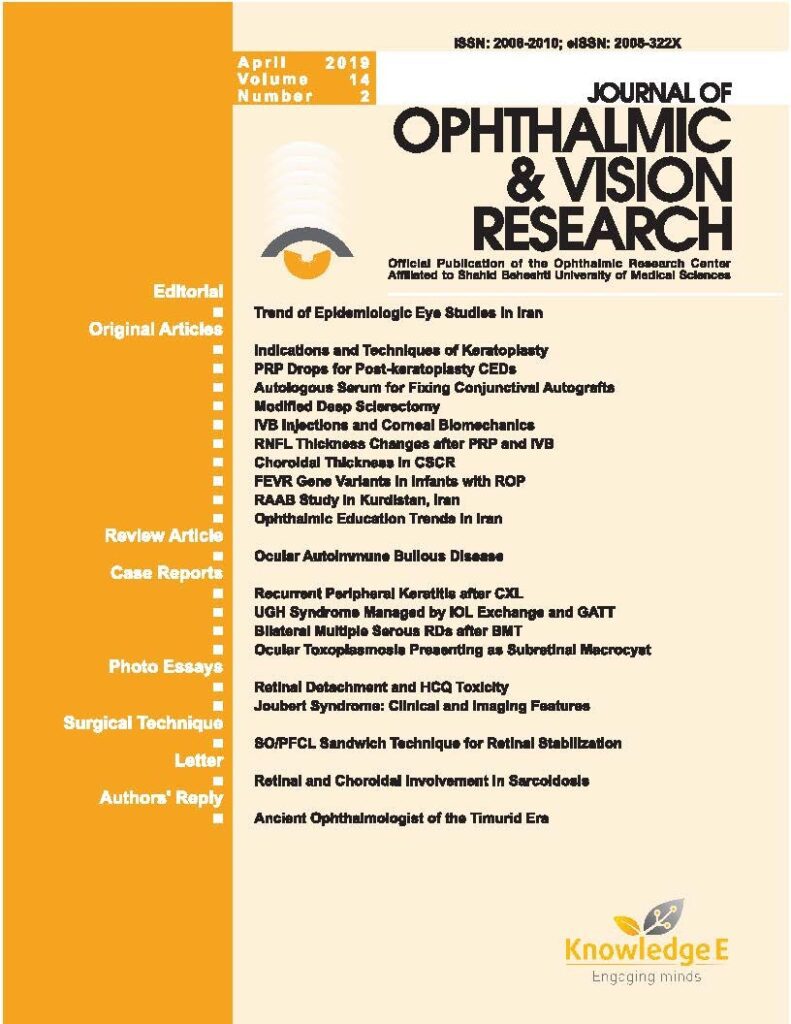
Journal of Ophthalmic and Vision Research
ISSN: 2008-322X
The latest research in clinical ophthalmology and the science of vision.
Bilateral Optic Disc Edema in a Patient with Lead Poisoning
Published date: Oct 24 2019
Journal Title: Journal of Ophthalmic and Vision Research
Issue title: October–December 2019, Volume 14, Issue 4
Pages: 513 – 517
Authors:
Abstract:
Purpose: Heavy metals, such as lead can cause optic neuropathy. Optic disc neuropathy due to lead intoxication has previously been reported. We report a rare case of lead toxicity-induced optic neuropathy presenting with bilateral hemorrhagic optic disc swelling.
Case Report: The patient was a 42-year-old man with a history of chronic oral opium use, who had a gradually progressing blurred vision in both eyes over 40 days, with ataxia, paresthesia, and a toxic level of serum lead. He had been treated with lead chelators for lead poisoning. His color vision was impaired in both eyes. Humphrey’s visual field test revealed double arcuate scotoma with enlargement of the blind spot. Funduscopy revealed bilateral optic disc swelling, which was confirmed on optical coherence tomography and fluorescein angiography.
Conclusion: In cases of optic disc edema, a comprehensive history should be taken to detect the cause. Further, in cases of chronic oral opium use, lead toxicity should be considered.
Keywords: Lead Poisoning, Opium Dependence, Optic Disc Edema, Paresthesia
References:
1. Jung JJ, Baek S-H, Kim US. Analysis of the causes of optic disc swelling. Korean J Ophthalmol 2011;25:33–36.
2. Sharma P, Sharma R. Toxic optic neuropathy. Indian J Ophthalmol 2011;59:137–141.
3. Report on carcinogens, fourteenth edition: lead and lead compounds [Internet]. National Toxicology Program, Department of Health and Human Services; 2004. Available from: https://ntp.niehs.nih.gov/ntp/roc/content/profiles/lead.pdf
4. Baghdassarian SA. Optic neuropathy due to lead poisoning: report of a case. Arch Ophthalmol 1968;80:721–723.
5. Fintak DR. Wills Eye Resident Case Series: review of ophthalmology. U.S.: Wills Eye Hospital; 2007 Jan 30. Available from: https://www.reviewofophthalmology.com/ article/wills-eye-resident-case-series-24966
6. Gilhotra JS, Lany HV, Sharp DM. Retinal lead toxicity. Indian J Ophthalmol 2007;55:152–154.
7. Sobieniecki A, Gutowska I, Machalińska A, Chlubek D. Retinal degeneration following lead exposure – functional aspects. Postepy Hig Med Dosw (online) 2015;69:1251–1258.
8. Salehi H, Sayadi AR, Tashakori M, Yazdandoost R, Soltanpoor N, Sadeghi H, et al. Comparison of serum lead level in oral opium addicts with healthy control group. Arch Iran Med 2009;12:555–558.
9. Gilhotra JS, Von Lany H, Sharp DM. Retinal lead toxicity. Indian J Ophthalmol 2007;55:152–154.
10. Wasinska-Borowiec W, Aghdam KA, Saari JM, Grzybowski A. An updated review on the most common agents causing toxic optic neuropathies. Curr Pharm Des 2017;23:586–595.
11. Ekinci M, Ceylan E, Cağatay HH, Keleş S, Altınkaynak H, Kartal B, et al. Occupational exposure to lead decreases macular, choroidal, and retinal nerve fiber layer thickness in industrial battery workers. Curr Eye Res 2014;39:853– 858.
12. Fox DA, Campbell ML, Blocker YS. Functional alterations and apoptotic cell death in the retina following developmental or adult lead exposure. Neurotoxicology 1997;18:645–664.